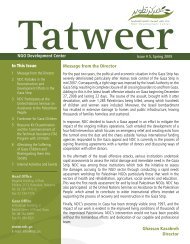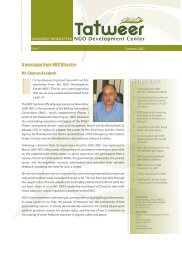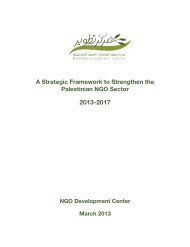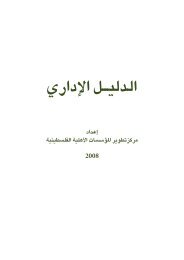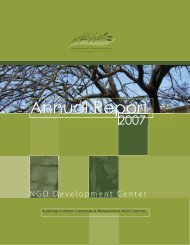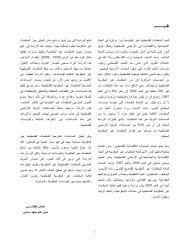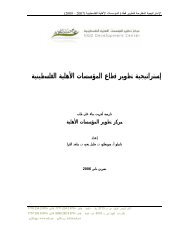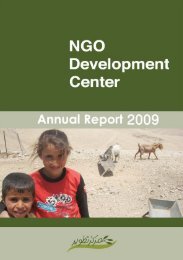Tracking External Donor Funding.pdf - NDC
Tracking External Donor Funding.pdf - NDC
Tracking External Donor Funding.pdf - NDC
Create successful ePaper yourself
Turn your PDF publications into a flip-book with our unique Google optimized e-Paper software.
As Figure 32 shows, donor government funding by target<br />
population shows a heavy focus upon urban areas, with<br />
the majority of the years measuring between 45 and 50%<br />
of total funding. When compared with the sectors funded<br />
by the government, this makes more sense. On average,<br />
governmental contributions to PNGOs working in the<br />
rural sector is lower than their nongovernmental<br />
counterparts. Unlike nongovernmental donors, however,<br />
donor governments contribute significantly to rural<br />
development through partnerships with the PA and local<br />
municipalities.<br />
Figure 32: <strong>External</strong> Governmental <strong>Funding</strong><br />
to Target Population (1999-2008)<br />
100%<br />
90%<br />
80%<br />
70%<br />
60%<br />
50%<br />
40%<br />
30%<br />
20%<br />
10%<br />
0%<br />
1999 2000 2001 2002 2003 2004 2005 2006 2007 2008<br />
Source: MAS, 2009 – <strong>Donor</strong> Survey<br />
Urban Rural Refugee<br />
With the exception of 2000 to 2002, donor government<br />
contributions to PNGOs working with refugees has<br />
remained low. Between 2002 and 2008, the percentage<br />
of total funding apportioned to this sector fell from<br />
27.4% to only 16%. Much like governmental work with<br />
rural communities, PNGOs are not the primary conduit<br />
of governmental development assistance to refugees.<br />
UNRWA, the largest UN agency with a budget<br />
extending into the hundreds of millions, is fully financed<br />
by nation state contributions to work with refugees above<br />
and beyond the efforts of the PA or PNGOs.<br />
3.8 <strong>Tracking</strong> <strong>External</strong>ly Funded PNGO<br />
Activities by Geography<br />
One of the primary tasks of our survey was to pinpoint<br />
the geographic location of external aid at the governorate<br />
and district level. Previous studies, such as Welfare<br />
1998, were unsuccessful in distinguishing between the<br />
location of partner PNGOs and the location of their<br />
work. Furthermore, there has been little analysis done on<br />
the location of donors themselves. Our geographical<br />
analysis of external funding and PNGOs focused on the<br />
geographic distribution of PNGOs, the geographic<br />
distribution of donors, the location of the HQs of<br />
external financed partner PNGOs and the geographic<br />
distribution externally financed project implementation.<br />
3.8.1 Geographic Distribution of PNGO HQs in<br />
the WB&GS<br />
<strong>Tracking</strong> the number and sector of PNGOs is not as<br />
difficult as tracking the location of the organizations<br />
themselves, and further, the location of their project<br />
implementation. As Figure 33 show, there is a marked<br />
difference between MAS and MoI data on the<br />
distribution of PNGOs. The trends from the MoI data of<br />
PNGO distribution align more closely with International<br />
Agency Distribution (focused on the central West Bank),<br />
while MAS's mapping spreads NGOs and their activities<br />
almost evenly throughout the West Bank. Most<br />
noticeable is the 2007 trend toward greater activity in the<br />
Northern West Bank as opposed to the Center. The<br />
following Figure 33 shows the distribution of PNGOs by<br />
region in the WB&GS in 1999 and 2006.<br />
47


